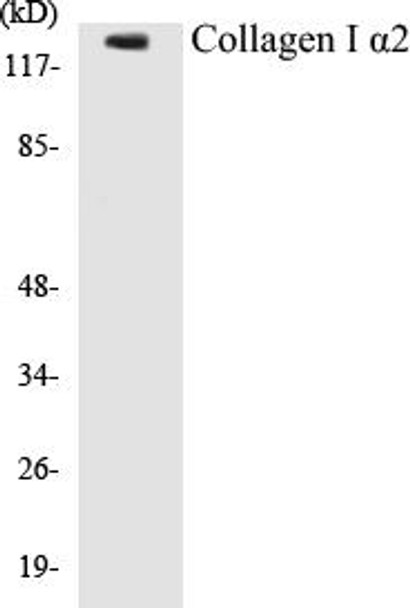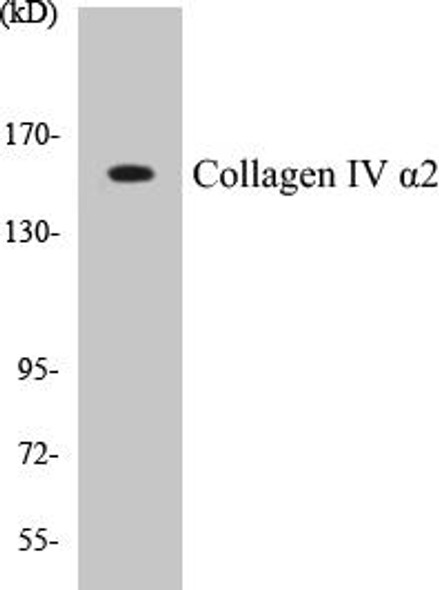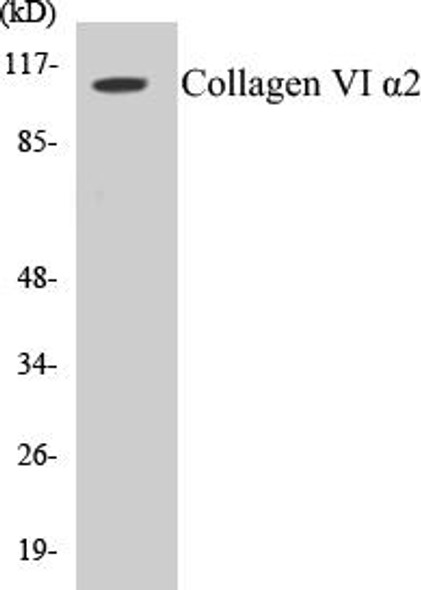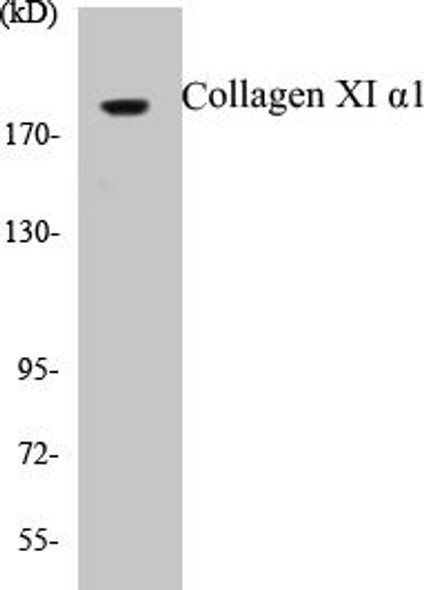Description
Collagen I alpha2 Colorimetric Cell-Based ELISA Kit
The Collagen I Alpha2 Colorimetric Cell-Based ELISA Kit is a reliable and accurate tool for the quantification of Collagen I Alpha2 levels in cell culture supernatants. This kit offers high sensitivity and specificity, providing researchers with dependable and reproducible results for a variety of research applications.Collagen I Alpha2 is a key component of the extracellular matrix and plays a crucial role in tissue development, repair, and remodeling. Abnormal levels of Collagen I Alpha2 have been associated with various diseases, such as fibrosis, arthritis, and cancer, making it a valuable biomarker for studying these conditions and developing therapeutic interventions.
By using the Collagen I Alpha2 Colorimetric Cell-Based ELISA Kit, researchers can gain valuable insights into the regulation of Collagen I Alpha2 in cell cultures, advancing our understanding of tissue biology and disease pathology. This kit is a valuable tool for anyone studying collagen biology and its implications in health and disease.
| Product Name: | Collagen I alpha2 Colorimetric Cell-Based ELISA |
| Product Code: | CBCAB00076 |
| ELISA Type: | Cell-Based |
| Target: | Collagen I alpha2 |
| Reactivity: | Human |
| Dynamic Range: | > 5000 Cells |
| Detection Method: | Colorimetric 450 nmStorage/Stability:4°C/6 Months |
| Format: | 96-Well Microplate |
The Collagen I alpha2 Colorimetric Cell-Based ELISA Kit is a convenient, lysate-free, high throughput and sensitive assay kit that can detect Collagen I alpha2 protein expression profile in cells. The kit can be used for measuring the relative amounts of Collagen I alpha2 in cultured cells as well as screening for the effects that various treatments, inhibitors (ie siRNA or chemicals), or activators have on Collagen I alpha2.
Qualitative determination of Collagen I alpha2 concentration is achieved by an indirect ELISA format. In essence, Collagen I alpha2 is captured by Collagen I alpha2-specific primary antibodies while the HRP-conjugated secondary antibodies bind the Fc region of the primary antibody. Through this binding, the HRP enzyme conjugated to the secondary antibody can catalyze a colorimetric reaction upon substrate addition. Due to the qualitative nature of the Cell-Based ELISA, multiple normalization methods are needed:
| 1. | A monoclonal antibody specific for human GAPDH is included to serve as an internal positive control in normalizing the target absorbance values. |
| 2. | Following the colorimetric measurement of HRP activity via substrate addition, the Crystal Violet whole-cell staining method may be used to determine cell density. After staining, the results can be analysed by normalizing the absorbance values to cell amounts, by which the plating difference can be adjusted. |
| Database Information: | Gene ID: 1278, UniProt ID: P08123, OMIM: 120160, Unigene: Hs.489142 |
| Gene Symbol: | COL1A2 |
| Sub Type: | None |
| UniProt Protein Function: | COL1A2: Type I collagen is a member of group I collagen (fibrillar forming collagen). Defects in COL1A2 are the cause of Ehlers-Danlos syndrome type 7B (EDS7B). EDS is a connective tissue disorder characterized by hyperextensible skin, atrophic cutaneous scars due to tissue fragility and joint hyperlaxity. EDS7B is marked by bilateral congenital hip dislocation, hyperlaxity of the joints, and recurrent partial dislocations. Defects in COL1A2 are a cause of osteogenesis imperfecta type 1 (OI1). A dominantly inherited connective tissue disorder characterized by bone fragility and blue sclerae. Osteogenesis imperfecta type 1 is non-deforming with normal height or mild short stature, and no dentinogenesis imperfecta. Defects in COL1A2 are a cause of osteogenesis imperfecta type 2 (OI2); also known as osteogenesis imperfecta congenita (OIC) or lethal perinatal. A connective tissue disorder characterized by bone fragility, with many perinatal fractures, severe bowing of long bones, undermineralization, and death in the perinatal period due to respiratory insufficiency. Defects in COL1A2 are the cause of Ehlers-Danlos syndrome autosomal recessive cardiac valvular form (EDSCV). A connective tissue disorder characterized by hyperextensible skin, atrophic cutaneous scars due to tissue fragility and joint hyperlaxity. In addition to joint laxity, skin hyperextensibility and friability, and abnormal scar formation, patients have mitral valve prolapse and insufficiency, mitral regurgitation, and aortic insufficiency. Defects in COL1A2 are a cause of osteogenesis imperfecta type 3 (OI3). A connective tissue disorder characterized by progressively deforming bones, very short stature, a triangular face, severe scoliosis, grayish sclera, and dentinogenesis imperfecta. Defects in COL1A2 are a cause of osteogenesis imperfecta type 4 (OI4); also known as osteogenesis imperfecta with normal sclerae. A connective tissue disorder characterized by moderately short stature, mild to moderate scoliosis, grayish or white sclera and dentinogenesis imperfecta. A chromosomal aberration involving COL1A2 may be a cause of lipoblastomas, which are benign tumors resulting from transformation of adipocytes, usually diagnosed in children. Translocation t(7;8)(p22;q13) with PLAG1. Belongs to the fibrillar collagen family. |
| UniProt Protein Details: | Protein type:Secreted, signal peptide; Secreted Chromosomal Location of Human Ortholog: 7q22.1 Cellular Component: collagen type I; endoplasmic reticulum lumen; extracellular matrix; extracellular region; extracellular space Molecular Function:extracellular matrix structural constituent; identical protein binding; metal ion binding; platelet-derived growth factor binding; protein binding; protein binding, bridging; SMAD binding Biological Process: blood coagulation; blood vessel development; collagen catabolic process; collagen fibril organization; extracellular matrix disassembly; extracellular matrix organization and biogenesis; leukocyte migration; odontogenesis; platelet activation; receptor-mediated endocytosis; regulation of blood pressure; regulation of immune response; Rho protein signal transduction; skeletal development; skin morphogenesis; transforming growth factor beta receptor signaling pathway Disease: Ehlers-danlos Syndrome, Autosomal Recessive, Cardiac Valvular Form; Ehlers-danlos Syndrome, Type Vii, Autosomal Dominant; Osteogenesis Imperfecta, Type Ii; Osteogenesis Imperfecta, Type Iii; Osteogenesis Imperfecta, Type Iv; Osteoporosis |
| NCBI Summary: | This gene encodes the pro-alpha2 chain of type I collagen whose triple helix comprises two alpha1 chains and one alpha2 chain. Type I is a fibril-forming collagen found in most connective tissues and is abundant in bone, cornea, dermis and tendon. Mutations in this gene are associated with osteogenesis imperfecta types I-IV, Ehlers-Danlos syndrome type VIIB, recessive Ehlers-Danlos syndrome Classical type, idiopathic osteoporosis, and atypical Marfan syndrome. Symptoms associated with mutations in this gene, however, tend to be less severe than mutations in the gene for the alpha1 chain of type I collagen (COL1A1) reflecting the different role of alpha2 chains in matrix integrity. Three transcripts, resulting from the use of alternate polyadenylation signals, have been identified for this gene. [provided by R. Dalgleish, Feb 2008] |
| UniProt Code: | P08123 |
| NCBI GenInfo Identifier: | 296439507 |
| NCBI Gene ID: | 1278 |
| NCBI Accession: | P08123.7 |
| UniProt Secondary Accession: | P08123,P02464, Q13897, Q13997, Q13998, Q14038, Q14057 Q15177, Q15947, Q16480, Q16511, Q7Z5S6, |
| UniProt Related Accession: | P08123 |
| Molecular Weight: | 129,314 Da |
| NCBI Full Name: | Collagen alpha-2(I) chain |
| NCBI Synonym Full Names: | collagen type I alpha 2 |
| NCBI Official Symbol: | COL1A2 |
| NCBI Official Synonym Symbols: | OI4 |
| NCBI Protein Information: | collagen alpha-2(I) chain |
| UniProt Protein Name: | Collagen alpha-2(I) chain |
| UniProt Synonym Protein Names: | Alpha-2 type I collagen |
| UniProt Gene Name: | COL1A2 |
| UniProt Entry Name: | CO1A2_HUMAN |
| Component | Quantity |
| 96-Well Cell Culture Clear-Bottom Microplate | 2 plates |
| 10X TBS | 24 mL |
| Quenching Buffer | 24 mL |
| Blocking Buffer | 50 mL |
| 15X Wash Buffer | 50 mL |
| Primary Antibody Diluent | 12 mL |
| 100x Anti-Phospho Target Antibody | 60 µL |
| 100x Anti-Target Antibody | 60 µL |
| Anti-GAPDH Antibody | 60 µL |
| HRP-Conjugated Anti-Rabbit IgG Antibody | 12 mL |
| HRP-Conjugated Anti-Mouse IgG Antibody | 12 mL |
| SDS Solution | 12 mL |
| Stop Solution | 24 mL |
| Ready-to-Use Substrate | 12 mL |
| Crystal Violet Solution | 12 mL |
| Adhesive Plate Seals | 2 seals |
The following materials and/or equipment are NOT provided in this kit but are necessary to successfully conduct the experiment:
- Microplate reader able to measure absorbance at 450 nm and/or 595 nm for Crystal Violet Cell Staining (Optional)
- Micropipettes with capability of measuring volumes ranging from 1 µL to 1 ml
- 37% formaldehyde (Sigma Cat# F-8775) or formaldehyde from other sources
- Squirt bottle, manifold dispenser, multichannel pipette reservoir or automated microplate washer
- Graph paper or computer software capable of generating or displaying logarithmic functions
- Absorbent papers or vacuum aspirator
- Test tubes or microfuge tubes capable of storing ≥1 ml
- Poly-L-Lysine (Sigma Cat# P4832 for suspension cells)
- Orbital shaker (optional)
- Deionized or sterile water
*Note: Protocols are specific to each batch/lot. For the correct instructions please follow the protocol included in your kit.
| Step | Procedure |
| 1. | Seed 200 µL of 20,000 adherent cells in culture medium in each well of a 96-well plate. The plates included in the kit are sterile and treated for cell culture. For suspension cells and loosely attached cells, coat the plates with 100 µL of 10 µg/ml Poly-L-Lysine (not included) to each well of a 96-well plate for 30 minutes at 37°C prior to adding cells. |
| 2. | Incubate the cells for overnight at 37°C, 5% CO2. |
| 3. | Treat the cells as desired. |
| 4. | Remove the cell culture medium and rinse with 200 µL of 1x TBS, twice. |
| 5. | Fix the cells by incubating with 100 µL of Fixing Solution for 20 minutes at room temperature. The 4% formaldehyde is used for adherent cells and 8% formaldehyde is used for suspension cells and loosely attached cells. |
| 6. | Remove the Fixing Solution and wash the plate 3 times with 200 µL 1x Wash Buffer for five minutes each time with gentle shaking on the orbital shaker. The plate can be stored at 4°C for a week. |
| 7. | Add 100 µL of Quenching Buffer and incubate for 20 minutes at room temperature. |
| 8. | Wash the plate 3 times with 1x Wash Buffer for 5 minutes each time. |
| 9. | Add 200 µL of Blocking Buffer and incubate for 1 hour at room temperature. |
| 10. | Wash 3 times with 200 µL of 1x Wash Buffer for 5 minutes each time. |
| 11. | Add 50 µL of 1x primary antibodies (Anti-Collagen I alpha2 Antibody and/or Anti-GAPDH Antibody) to the corresponding wells, cover with Parafilm and incubate for 16 hours (overnight) at 4°C. If the target expression is known to be high, incubate for 2 hours at room temperature. |
| 12. | Wash 3 times with 200 µL of 1x Wash Buffer for 5 minutes each time. |
| 13. | Add 50 µL of 1x secondary antibodies (HRP-Conjugated AntiRabbit IgG Antibody or HRP-Conjugated Anti-Mouse IgG Antibody) to corresponding wells and incubate for 1.5 hours at room temperature. |
| 14. | Wash 3 times with 200 µL of 1x Wash Buffer for 5 minutes each time. |
| 15. | Add 50 µL of Ready-to-Use Substrate to each well and incubate for 30 minutes at room temperature in the dark. |
| 16. | Add 50 µL of Stop Solution to each well and read OD at 450 nm immediately using the microplate reader. |
(Additional Crystal Violet staining may be performed if desired – details of this may be found in the kit technical manual.)






